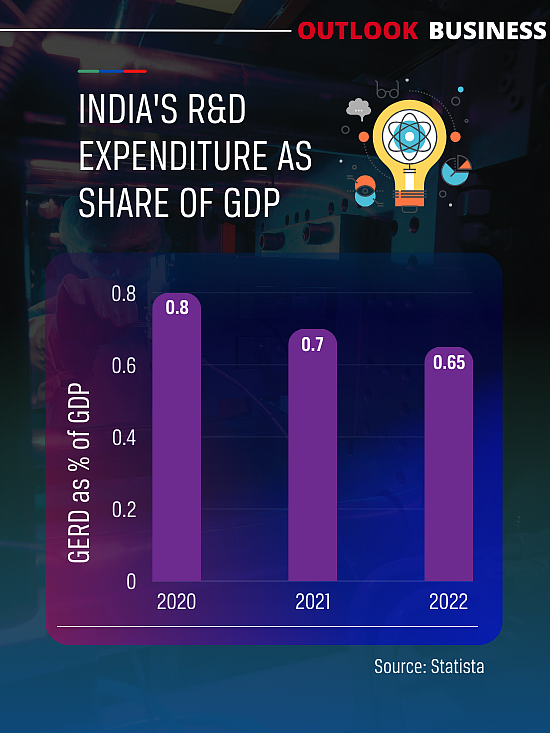Infosys co-founder Narayana Murthy’s word of advice for youngers had managed to stir a storm as he asked them to work 70 hours every week. As per Murthy, this will help India catch up developed economies by increasing productivity. But in a country where working hours are already amongst the highest in the world and productivity amongst the lowest, is this the only way?
Studies have shown that spending on research and development (R&D) is one of the most potent methods available at the disposal of Indian corporate leaders to boost productivity. However, India Inc continues to ignore the dire need for R&D. US-based OpenAI’s ChatGPT and other remarkable innovations in artificial intelligence have managed to usher in a new age of AI.
The new reality threatens to upend industries and replace over 300 million jobs, a Goldman Sachs report noted recently. The need to innovate and invest for companies has never been more critical, particularly for the information technology (IT) firms. But are they stepping up?
Outlook Business analysed the total R&D spend of 532 companies whose data was available over the last six financial years. The result of the analysis paints a worrying picture of the state of research and development in the country.
Sluggish R&D
Analysing the IT firms present in the dataset, R&D spends have grown in most of the financial years, beating the trend of declining R&D expenditure of broader industry. However, the intensity of R&D, measured as share of R&D expenses in total revenue, remains low.

Notably, the share of IT companies’ R&D expenses in revenue saw a sharp rise in the last financial year after years of continuous decline. With the role of AI increasing, the share in revenue may rise even further as IT firms look to keep pace with emerging technologies.
With India aiming for integration in global manufacturing, firms in the sector are expected to compete with global companies and make a mark in supply chains. Most of the firms analysed in the dataset are manufacturing companies. Looking at the cumulative spending of all the firms in the sample, the data shows that the share of R&D expenditure in companies has remained nearly the same in the last five years at 0.3 per cent.

While the share of revenue has remained stagnant, what should worry is the growth in R&D expenditure which has lost steam in the last few years. From 11 per cent overall year-on-year growth in FY19, aggregate R&D expenses declined by nearly 9 per cent in FY23. Breaking this down sector wise, both manufacturing and services’ firms have seen a decline in growth in their R&D spends.

While less R&D hurts innovation, researchers Mingqian Zhang and Pierre Mohnen found in an analysis of Chinese firms that chances of survival increased with more R&D spends. They noted, “We find that both R&D and product innovation increase the chance of survival. Contrary to some previous studies, we find that being in dynamic industries—R&D-intensive, with high sales or R&D volatility—reduces even more the hazard rate when doing R&D or being innovative.”
Fitting into the broader picture, low R&D by private sector has dragged down the overall share of expenses on research in India’s GDP. The slow pace in investment leaves most of the weight to be borne by the government.
Need To Boost
Data shows that India’s R&D expenditure as share of GDP has consistently declined over the years. On one hand, global expenditure on R&D increased from 2 per cent of GDP in 2011 to 2.5 per cent in 2020, India’s spending on R&D remained stagnant around 0.8 per cent in the decade. Post the pandemic, the situation has progressively worsened. Growth in India’s labour productivty has also fell off the cliff in the last few years. From growth of 9.1 per cent in 2016, it fell to mere 2.53 per cent in 2022.

As the government targets the goal of making India the largest economy in the world, it has been noted time and again that the country shouldn’t be lagging the world. An Invest India report had found that the only 26 Indian companies were part of top 2,500 firms in terms of R&D expenditure. Compared to this, the list consists of more than 300 Chinese firms.
The need to boost R&D spending has been noted time and again. NITI Aayog’s India Innovation Index 2021 noted that India is lagging behind countries like Russia, Brazil and Malaysia in terms of R&D expenditure. The government’s think tank had noted in its report, “This needs to change. India needs to find that inflexion point after which the private sector can take over.” The latest data suggests that the private sector has not stepped up yet.
An analysis by RBI published last year had also noted that the intensity of R&D expenditure in India is low. This in turn could hit the growth of the manufacturing sector in the country, whose gross value added as percentage of GDP has consistently declined over the last decade. World Bank data showed that it has declined from 16 per cent in 2015 to 13 per cent at the end of 2022.
Organisation for economic cooperation and development (OECD) had said in a note, “Investing in innovation and upgrading to higher value-added activities can boost productivity, create better paid jobs and strengthen growth. As such, addressing the barriers to enhanced innovation performance is essential.”
Increasing workers’ productivity, improving quality of jobs and establishing manufacturing prowess are all the boxes Indian policymakers want to check while aiming for the $5 trillion tag. However, without India Inc stepping up for R&D and improving the innovation output, will it be possible to make a mark in global supply chains?



























